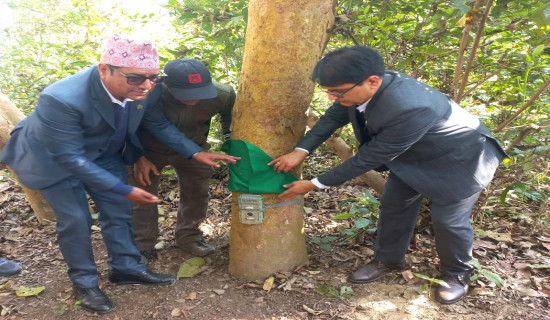- Tuesday, 16 December 2025
Air Pollution Detrimental To Human Health
The Kathmandu Valley has lately witnessed the worst air quality among cities in the world. Air Quality Index (AQI) in the country particularly in Kathmandu had crossed hazardous levels for a few days in the last week posing a serious threat to the health of the millions. This has resulted in an increased number of hospital admissions associated with respiratory ailments. The topography of the valley is one of the reasons for such a high level of pollution and a mix of weather, vehicular emission, industrial pollution, and uncontrolled seasonal wildfires has contributed to it.
Air pollution is caused by the presence of toxic substances in the atmosphere owing to human activities such as vehicular emission, industrial activities, unplanned urbanisation, and open burning. However, natural disasters such as dust storms and wildfires have further deteriorated the air quality.
Alarming increase
People can avoid smoking but not air pollution. It kills more people than smoking does. An estimated 8 million deaths are reported worldwide every year due to air pollution whereas 7 million in the year 2016 attributed to smoking (WHO, 2018). Deaths due to air pollution include both ambient or outdoor (4.2 million) and household or indoor (3.8 million) air pollution. Over 90 per cent of those deaths occur in low- and middle-income countries in Asia and Africa. Air pollution reduces 1.8 years of life compared to 1.6 years from smoking, 11 months by excessive alcohol and drug use, and 7 months by unsafe water, sanitation, and hand washing (World Economic Forum, 2018).
The number of pollution-related diseases, including respiratory infections, heart disease, chronic obstructive pulmonary diseases (COPD), stroke, and lung cancer are increasing alarmingly worldwide, particularly in low- and middle-income countries. Air pollution is, thus, a silent killer mainly responsible for causing a variety of chronic and acute respiratory conditions. A total of 12.6 million deaths are due to unhealthy environments (WHO, 2020). In fact, low- and middle-income countries are exposed to the highest level of exposure and it has been estimated that 9 out of 10 people breathe unsafe air with high levels of toxic pollutants.
The migration of the human population in cities and urban development are increasing at unprecedented rates and creating tremendous pressure on local, regional, and global air quality. Nepal ranked 176th position among 180 countries on the environmental performance index and 180th in terms of air quality as conducted by Yale University in 2018. In 2016, Nepal ranked 177th among 180 countries in air quality. It shows the quality of our environment deteriorated over time instead of improving. The effects of poor air quality on human health are complex but principally cause harm to the human respiratory and cardiovascular systems. Individual reactions to air pollutants vary on the type of pollutant, the degree of exposure, the health status, and genetic predisposition.
Poor-quality roads, construction sites, and wildfires generate particulate matter (PM 10) which is a suspended particle of about 10 µm diametre that causes irritation to the eyes, nose, and throat and is linked to acute respiratory illnesses. Particles less than 2.5 µm in diametre (PM 2.5) penetrate deep into the lung causing irritation and impairing lung function and can even circulate in the blood. Moreover, exposure to PM 2.5 is linked to decreased life expectancy.
Air pollution results in ozone depletion, and is linked to causing cardiovascular and respiratory diseases. Another pollutant, benzene can cause eye, skin, and lung irritation in the short term, and in the long term, it causes blood disorders. Dioxins affect the liver in the short term and harm the immune, nervous, and endocrine systems, as well as reproductive functions. Lead can damage children’s brains and kidneys in large amounts, and even in small amounts, it can affect the development of children and their ability to learn. Mercury affects the central nervous system.
Traffic exhaust and wildfire smoke release Polycyclic Aromatic Hydrocarbons (PAH), which are linked to eye and lung irritation, blood and liver diseases, and can even cause cancer. Air pollution is also linked to autoimmune diseases. In totality, air pollution has been emerging as a major global public health threat.
Measures
Nepal, despite having several policies and guidelines on environmental issues, is yet to have an impact on the improvement in air quality and reduction of health effects due to air pollution. The current situation of air pollution is a health emergency and efficient control of wildfires is the current need and should be carried out immediately. Banning open burning, monitoring pollution-producing industries, replacing old and malfunctioned vehicles, encouraging the use of energy-efficient equipment, and promoting the use of renewable energy require commitment from both the government and the responsible general public.
During times of the hazardous level of air pollution, the general public is urged to stay inside their home with all the windows shut and limit their outdoor activities including daily exercise. Long-term strategies such as renewable fuel and clean energy production, energy conservation and efficiency, eco-friendly transportation, and green building should be realised and implemented strictly. Awareness of the impact of poor quality air on health has not yet reached the general public level. Therefore, large-scale awareness campaigns on it and promotion of preventive measures are vital for controlling it. Lastly, it is our responsibility to keep the environment safe for our future generations.
(Dr. Lohani is the clinical director at the Nepal Drug and Poison Information Centre. lohanis@gmail.com)

















